QGIS MapServer 配置IIS 6及Apache
MapGIS IGServer配置指南for DNET

MapServer的安装和使用
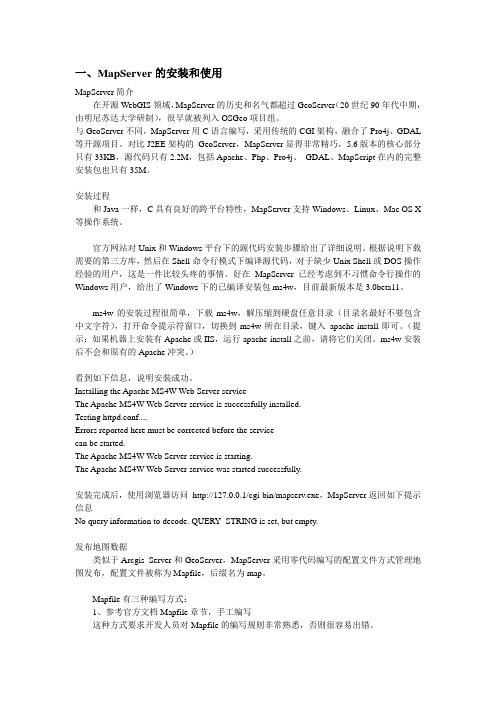
一、MapServer的安装和使用MapServer简介在开源WebGIS领域,MapServer的历史和名气都超过GeoServer(20世纪90年代中期,由明尼苏达大学研制),很早就被列入OSGeo项目组。
与GeoServer不同,MapServer用C语言编写,采用传统的CGI架构,融合了Pro4j、GDAL 等开源项目。
对比J2EE架构的GeoServer,MapServer显得非常精巧,5.6版本的核心部分只有33KB,源代码只有2.2M,包括Apache、Php、Pro4j、GDAL、MapScript在内的完整安装包也只有35M。
安装过程和Java一样,C具有良好的跨平台特性,MapServer支持Windows、Linux、Mac OS X 等操作系统。
官方网站对Unix和Windows平台下的源代码安装步骤给出了详细说明。
根据说明下载需要的第三方库,然后在Shell命令行模式下编译源代码,对于缺少Unix Shell或DOS操作经验的用户,这是一件比较头疼的事情。
好在MapServer已经考虑到不习惯命令行操作的Windows用户,给出了Windows下的已编译安装包ms4w,目前最新版本是3.0beta11。
ms4w的安装过程很简单,下载ms4w,解压缩到硬盘任意目录(目录名最好不要包含中文字符),打开命令提示符窗口,切换到ms4w所在目录,键入apache-install即可。
(提示:如果机器上安装有Apache或IIS,运行apache-install之前,请将它们关闭。
ms4w安装后不会和原有的Apache冲突。
)看到如下信息,说明安装成功。
Installing the Apache MS4W Web Server serviceThe Apache MS4W Web Server service is successfully installed.Testing httpd.conf....Errors reported here must be corrected before the servicecan be started.The Apache MS4W Web Server service is starting.The Apache MS4W Web Server service was started successfully.安装完成后,使用浏览器访问http://127.0.0.1/cgi-bin/mapserv.exe,MapServer返回如下提示信息No query information to decode. QUERY_STRING is set, but empty.发布地图数据类似于Arcgis Server和GeoServer,MapServer采用零代码编写的配置文件方式管理地图发布,配置文件被称为Mapfile,后缀名为map。
IIS6部署WebAPI网站配置

IIS6部署WebAPI网站配置
本文档解决WebAPI调用时返回404错误
注:下列演示版本为1.1,实际版本为项目使用版本
1.打开IIS管理器,在需要配置的网站右键菜单中点击“属性”菜单项,打开“网站属性”
窗口。
2.在网站属性窗口中,选择主目录选项卡,点击“配置”按钮打开“应用程序配置”窗口。
3.在“应用程序配置”窗口中,选择“映射”选项卡,在“应用程序扩展”列表框中选择
“扩展名”为“.aspx”的项,点击“编辑”按钮打开“添加/编辑应用程序扩展名映射”
窗口。
4.在“添加/编辑应用程序扩展名映射”窗口中,复制“可执行文件”文本框中的内容,
之后点击“取消”按钮,返回“应用程序配置”窗口。
5.在“应用程序配置窗口”中点击“插入”按钮,打开“添加/编辑应用程序扩展名映射”
窗口。
6.在“添加/编辑应用程序扩展名映射”窗口中,将在第4步中复制的内容粘贴到“可执
行文件”文本框中,取消选中“确认文件是否存在”复选框,点击“确定”按钮返回“应用程序配置”窗口。
注:必须取消选中“确认文件是否存在”复选框,否则会没有效果!!!!!!
7.在“应用程序配置”窗口中点击“确定”按钮关闭该窗口,配置完成。
关于使用isatap隧道访问ipv6网络的配置说明
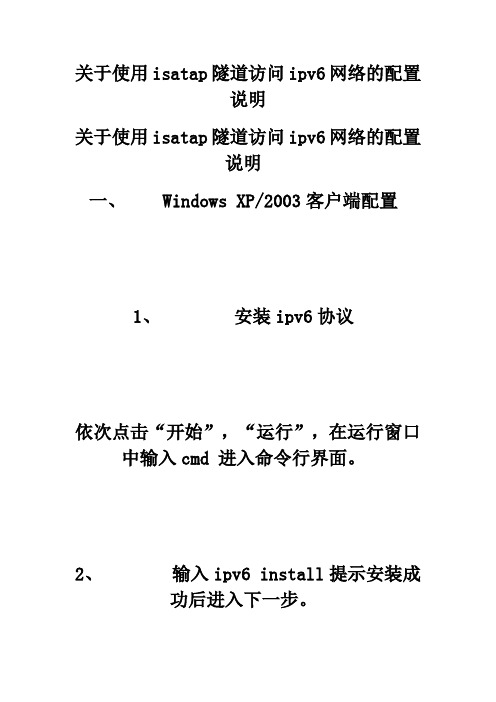
关于使用isatap隧道访问ipv6网络的配置说明关于使用isatap隧道访问ipv6网络的配置说明一、 Windows XP/2003客户端配置1、安装ipv6协议依次点击“开始”,“运行”,在运行窗口中输入cmd 进入命令行界面。
2、输入ipv6 install提示安装成功后进入下一步。
此主题相关图片如下:3、输入netsh 此主题相关图片如下:4、输入 int ipv6 isatap 进入isatap配置模式5、输入set router .cn en,配置isatap路由器6、输入exit退出netsh二、 Windows vista/7 客户端配置Windows vista/7已自带ipv6支持,无需单独安装。
配置步骤如下:1、以管理员身份运行cmd命令,进入命令行模式。
这个地方我提一下,这个需要管理员身份,不知道怎么搞的可以百度2、输入netsh3、输入int ipv6 isatap,进入isatap配置模式4、输入set router .cn en,配置isatap路由器5、输入set state ena,激活isatap隧道6、输入exit,退出netsh7、右键点击桌面“计算机”图标,选择“管理”,展开“服务和应用程序”,确认ip helper服务已开启此主题相关图片如下:三、测试配置结果1、点击开始、运行,输入cmd 进入命令行2、输入ipconfig 查看是否有2001开头的地址,若有,说明已获得IPV6地址3、用浏览器打开http://media6.njtu. /address.asp,页面中会显示类似如下信息:你正使用IPv6地址是:2001:250:5405:1:2 00:5efe:210.45.191.60其中2001之后的即为你的IPV6地址。
使用过程中如有其它问题请到与网络中心联系或到青禾BBS(校园网管理板块)发帖讨论。
PS.常用ipv6资源: 如果你是ipv6,会看到运动的乌龟 全国有名的IPV6 bt下载站 科大ipv6影视 工大ipv6影视大家有什么比较好的IPV6站点,也请发上来分享一下:)。
JBoss6 + apache httpd-2.2.21集群配置
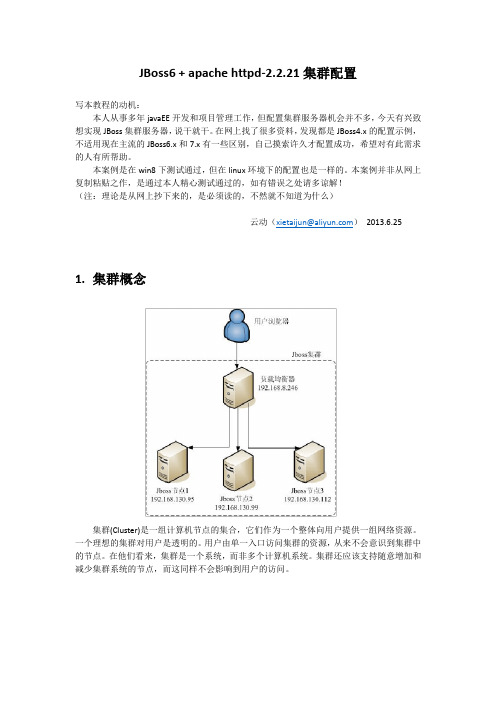
JBoss6 + apache httpd-2.2.21集群配置写本教程的动机:本人从事多年javaEE开发和项目管理工作,但配置集群服务器机会并不多,今天有兴致想实现JBoss集群服务器,说干就干。
在网上找了很多资料,发现都是JBoss4.x的配置示例,不适用现在主流的JBoss6.x和7.x有一些区别,自己摸索许久才配置成功,希望对有此需求的人有所帮助。
本案例是在win8下测试通过,但在linux环境下的配置也是一样的。
本案例并非从网上复制粘贴之作,是通过本人精心测试通过的,如有错误之处请多谅解!(注:理论是从网上抄下来的,是必须读的,不然就不知道为什么)云动(xietaijun@)2013.6.25 1.集群概念集群(Cluster)是一组计算机节点的集合,它们作为一个整体向用户提供一组网络资源。
一个理想的集群对用户是透明的。
用户由单一入口访问集群的资源,从来不会意识到集群中的节点。
在他们看来,集群是一个系统,而非多个计算机系统。
集群还应该支持随意增加和减少集群系统的节点,而这同样不会影响到用户的访问。
1.1.集群分类习惯上,把集群分为高可用(High Availability,简称HA )集群和高性能计算(High Perfermance Computing,简称HPC )集群两类。
1) HA集群的目标是提高系统的可使用性(availability),即可靠性(reliability)和可维护性(maintainability)。
请不要将集群中的可使用性(availability)与UE和交互设计中的可用性(Usability)混淆。
HA集群的核心是防止单点失效,这一般是通过失败转移来实现的,即在一个节点失效后由另一个节点接替服务。
不丢失用户状态。
HA集群的其他主要特性还包括负载均衡、session同步等。
我们使用的SQL Server数据库的双机热备和Oracle的RAC都属于HA集群。
MapServer安装配置说明
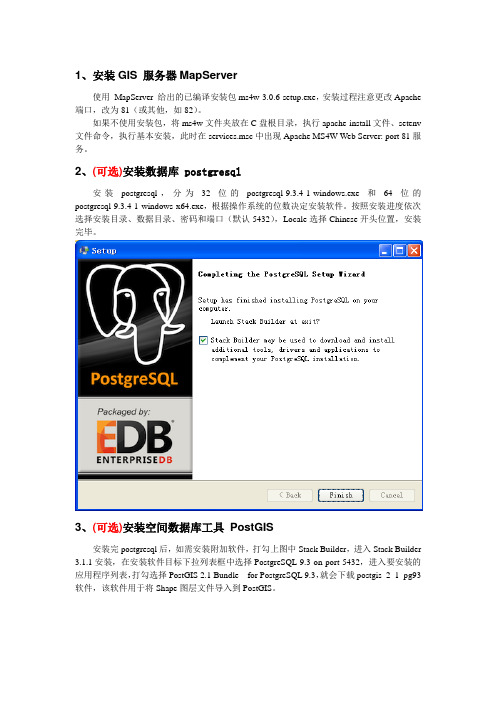
1、安装GIS 服务器MapServer使用MapServer 给出的已编译安装包ms4w-3.0.6-setup.exe,安装过程注意更改Apache 端口,改为81(或其他,如82)。
如果不使用安装包,将ms4w文件夹放在C盘根目录,执行apache-install文件、setenv 文件命令,执行基本安装,此时在services.msc中出现Apache MS4W Web Server: port 81服务。
2、(可选)安装数据库postgresql安装postgresql,分为32位的postgresql-9.3.4-1-windows.exe和64位的postgresql-9.3.4-1-windows-x64.exe,根据操作系统的位数决定安装软件。
按照安装进度依次选择安装目录、数据目录、密码和端口(默认5432),Locale选择Chinese开头位置,安装完毕。
3、(可选)安装空间数据库工具PostGIS安装完postgresql后,如需安装附加软件,打勾上图中Stack Builder,进入Stack Builder 3.1.1安装,在安装软件目标下拉列表框中选择PostgreSQL 9.3 on port 5432,进入要安装的应用程序列表,打勾选择PostGIS 2.1 Bundle for PostgreSQL 9.3,就会下载postgis_2_1_pg93软件,该软件用于将Shape图层文件导入到PostGIS。
下载完成执行安装,或安装已下载的postgis_2_1_pg93.exe软件进行安装,在安装过程,如下图打勾Create spatial database。
在数据库连接用户信息中,用户名为postgres,密码为123。
数据库名称改为nanning。
4、(可选)Shape图层文件导入到PostgreSQL打开pgAdmin,在插件栏打开PostGIS,或通过程序打开PostGIS 2.1。
QGIS MapServer 配置IIS 6及Apache
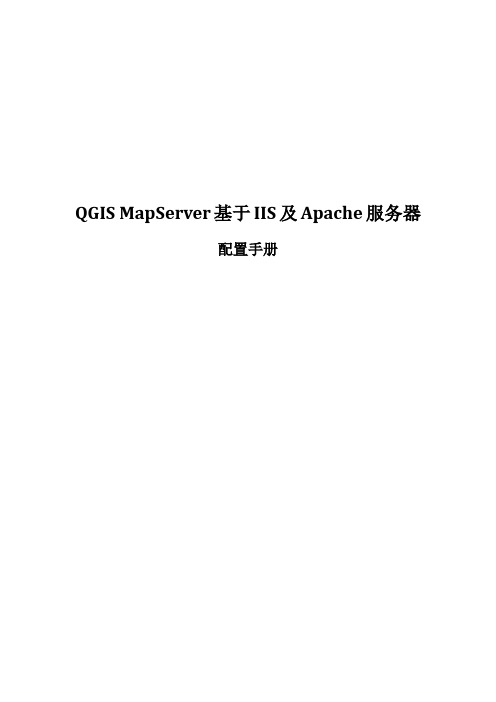
QGIS MapServer基于IIS及Apache服务器配置手册1. IIS 6.0配置步骤: (3)1.1. 安装Fastcgi IIS扩展程序 (3)1.2. 配置IIS扩展映射 (3)1.3. 配置MAP FCGI程序 (4)1.4. 修改FCGI配置文件 (4)1.5. 测试程序 (5)1.1.1. 最简单的测试程序(gisServerIIS.html) (5)1.1.2. 基于OpenLayers的测试程序 (5)2. Apache服务器配置 (5)1.IIS 6.0配置步骤:1.1.安装Fastcgi IIS扩展程序安装文件:fcgisetup_1.5_rtw_x86.msi安装完后应该在:C:\WINDOWS\system32\inetsrv目录下找到fcgiext.dll,fcgiext.ini,fcgiconfig.js等文件1.2.配置IIS扩展映射步骤详见下图:1.3.配置MAP FCGI程序修改程序(qgis_mapserv.exe.fcgi)所在目录的执行权限为“脚本和可执行文件”:1.4.修改FCGI配置文件修改文件(C:\WINDOWS\system32\inetsrv\fcgiext.ini):在文件中增加以下内容(参数值可根据需要修改):[Types]fcgi=FCGI[FCGI]ExePath=C:\Inetpub\wwwroot\project\qgis_mapserv.exe.fcgi;EnvironmentVars=FcgidMinProcessesPerClass:0,FcgidIdleScanInterval:1,FcgidProcessLifeTime:10 0MaxInstances=8RequestTimeout=3601.5.测试程序注意:1、WMS Server端只处理UTF8编码请求,所在在客户端脚本中增加以下内容:<meta http-equiv="Content-Type" content="text/html; charset=UTF-8"/>2、WMS1.3的BBOX坐标为倒置,即纬度在前;1.1.1.最简单的测试程序(gisServerIIS.html)功能:完成一次WMS请求代码中以下内容请根据不同机器及应用的情况进行修改:action="/project/qgis_mapserv.exe.fcgi"<input type="hidden" name="LAYERS" value="xxx行政区划"><input type="hidden" name="BBOX" value="29.494642,87.140300,54.824900,136.763000"> 1.1.2.基于OpenLayers的测试程序请参见OpenLayersopenlayers\examples\ wms-fjmiis.html功能:可进行地图浏览操作,平衡,放大,缩小2.Apache服务器配置基于Apache/2.2.21版本修改:D:\ms4w\Apache\conf\httpd.conf文件,详细修改请参见以下红色部分内容(修改后需重启Apache服务器)[httpd.conf范例]## This is the main Apache HTTP server configuration file. It contains the# configuration directives that give the server its instructions.# See <URL:/docs/2.2> for detailed information.# In particular, see# <URL:/docs/2.2/mod/directives.html># for a discussion of each configuration directive.## Do NOT simply read the instructions in here without understanding# what they do. They're here only as hints or reminders. If you are unsure # consult the online docs. You have been warned.## Configuration and logfile names: If the filenames you specify for many# of the server's control files begin with "/" (or "drive:/" for Win32), the# server will use that explicit path. If the filenames do *not* begin# with "/", the value of ServerRoot is prepended -- so "logs/foo.log"# with ServerRoot set to "d:/ms4w/Apache" will be interpreted by the# server as "d:/ms4w/Apache/logs/foo.log".## NOTE: Where filenames are specified, you must use forward slashes# instead of backslashes (e.g., "c:/apache" instead of "c:\apache").# If a drive letter is omitted, the drive on which httpd.exe is located# will be used by default. It is recommended that you always supply# an explicit drive letter in absolute paths to avoid confusion.## ServerRoot: The top of the directory tree under which the server's# configuration, error, and log files are kept.## Do not add a slash at the end of the directory path. If you point# ServerRoot at a non-local disk, be sure to point the LockFile directive# at a local disk. If you wish to share the same ServerRoot for multiple# httpd daemons, you will need to change at least LockFile and PidFile.#ServerRoot "d:/ms4w/Apache"## Listen: Allows you to bind Apache to specific IP addresses and/or# ports, instead of the default. See also the <VirtualHost># directive.## Change this to Listen on specific IP addresses as shown below to# prevent Apache from glomming onto all bound IP addresses.##Listen 12.34.56.78:80Listen 8089## Dynamic Shared Object (DSO) Support## To be able to use the functionality of a module which was built as a DSO you # have to place corresponding `LoadModule' lines at this location so the# directives contained in it are actually available _before_ they are used.# Statically compiled modules (those listed by `httpd -l') do not need# to be loaded here.## Example:# LoadModulefoo_module modules/mod_foo.so#LoadModuleactions_module modules/mod_actions.soLoadModulealias_module modules/mod_alias.soLoadModuleasis_module modules/mod_asis.soLoadModuleauth_basic_module modules/mod_auth_basic.so#LoadModuleauth_digest_module modules/mod_auth_digest.so#LoadModuleauthn_alias_module modules/mod_authn_alias.so#LoadModuleauthn_anon_module modules/mod_authn_anon.so#LoadModuleauthn_dbd_module modules/mod_authn_dbd.so#LoadModuleauthn_dbm_module modules/mod_authn_dbm.so LoadModuleauthn_default_module modules/mod_authn_default.so LoadModuleauthn_file_module modules/mod_authn_file.so#LoadModuleauthnz_ldap_module modules/mod_authnz_ldap.so#LoadModuleauthz_dbm_module modules/mod_authz_dbm.so LoadModuleauthz_default_module modules/mod_authz_default.so LoadModuleauthz_groupfile_module modules/mod_authz_groupfile.so LoadModuleauthz_host_module modules/mod_authz_host.so#LoadModuleauthz_owner_module modules/mod_authz_owner.so LoadModuleauthz_user_module modules/mod_authz_user.so LoadModuleautoindex_module modules/mod_autoindex.so#LoadModulecache_module modules/mod_cache.so#LoadModulecern_meta_module modules/mod_cern_meta.so LoadModulecgi_module modules/mod_cgi.soLoadModulecharset_lite_module modules/mod_charset_lite.so#LoadModuledav_module modules/mod_dav.so#LoadModuledav_fs_module modules/mod_dav_fs.so#LoadModuledav_lock_module modules/mod_dav_lock.so#LoadModuledbd_module modules/mod_dbd.so#LoadModuledeflate_module modules/mod_deflate.soLoadModuledir_module modules/mod_dir.so#LoadModuledisk_cache_module modules/mod_disk_cache.so#LoadModuledumpio_module modules/mod_dumpio.so LoadModuleenv_module modules/mod_env.so#LoadModuleexpires_module modules/mod_expires.so#LoadModuleext_filter_module modules/mod_ext_filter.so#LoadModulefile_cache_module modules/mod_file_cache.so#LoadModulefilter_module modules/mod_filter.so#LoadModuleheaders_module modules/mod_headers.so#LoadModuleident_module modules/mod_ident.so#LoadModuleimagemap_module modules/mod_imagemap.so LoadModuleinclude_module modules/mod_include.so#LoadModuleinfo_module modules/mod_info.so LoadModuleisapi_module modules/mod_isapi.so#LoadModuleldap_module modules/mod_ldap.so#LoadModulelogio_module modules/mod_logio.soLoadModulelog_config_module modules/mod_log_config.so#LoadModulelog_forensic_module modules/mod_log_forensic.so#LoadModulemem_cache_module modules/mod_mem_cache.so LoadModulemime_module modules/mod_mime.so#LoadModulemime_magic_module modules/mod_mime_magic.so LoadModulenegotiation_module modules/mod_negotiation.so#LoadModuleproxy_module modules/mod_proxy.so#LoadModuleproxy_ajp_module modules/mod_proxy_ajp.so#LoadModuleproxy_balancer_module modules/mod_proxy_balancer.so #LoadModuleproxy_connect_module modules/mod_proxy_connect.so #LoadModuleproxy_ftp_module modules/mod_proxy_ftp.so#LoadModuleproxy_http_module modules/mod_proxy_http.so#LoadModuleproxy_scgi_module modules/mod_proxy_scgi.so#LoadModulereqtimeout_module modules/mod_reqtimeout.so#LoadModulerewrite_module modules/mod_rewrite.so LoadModulesetenvif_module modules/mod_setenvif.so#LoadModulespeling_module modules/mod_speling.so#LoadModulessl_module modules/mod_ssl.so#LoadModulestatus_module modules/mod_status.so#LoadModulesubstitute_module modules/mod_substitute.so#LoadModuleunique_id_module modules/mod_unique_id.so#LoadModuleuserdir_module modules/mod_userdir.so#LoadModuleusertrack_module modules/mod_usertrack.so#LoadModuleversion_module modules/mod_version.so#LoadModulevhost_alias_module modules/mod_vhost_alias.so LoadModulefcgid_module modules/mod_fcgid.so#LoadModulefcgid_modulefcgi-bin/qgis_mapserv.fcgi<IfModule !mpm_netware_module><IfModule !mpm_winnt_module>## If you wish httpd to run as a different user or group, you must run# httpd as root initially and it will switch.## User/Group: The name (or #number) of the user/group to run httpd as.# It is usually good practice to create a dedicated user and group for# running httpd, as with most system services.#User daemonGroup daemon</IfModule></IfModule># 'Main' server configuration## The directives in this section set up the values used by the 'main'# server, which responds to any requests that aren't handled by a# <VirtualHost> definition. These values also provide defaults for# any<VirtualHost> containers you may define later in the file.## All of these directives may appear inside <VirtualHost> containers,# in which case these default settings will be overridden for the# virtual host being defined.### ServerAdmin: Your address, where problems with the server should be# e-mailed. This address appears on some server-generated pages, such# as error documents. e.g. admin@#ServerAdmin admin@## ServerName gives the name and port that the server uses to identify itself. # This can often be determined automatically, but we recommend you specify # it explicitly to prevent problems during startup.## If your host doesn't have a registered DNS name, enter its IP address here. ##ServerName :80## DocumentRoot: The directory out of which you will serve your# documents. By default, all requests are taken from this directory, but# symbolic links and aliases may be used to point to other locations.#DocumentRoot "d:/ms4w/Apache/htdocs"## Each directory to which Apache has access can be configured with respect# to which services and features are allowed and/or disabled in that# directory (and its subdirectories).## First, we configure the "default" to be a very restrictive set of# features.#<Directory />Options FollowSymLinksAllowOverride NoneOrder deny,allowDeny from all</Directory>## Note that from this point forward you must specifically allow# particular features to be enabled - so if something's not working as# you might expect, make sure that you have specifically enabled it# below.### This should be changed to whatever you set DocumentRoot to.#<Directory "d:/ms4w/Apache/htdocs">## Possible values for the Options directive are "None", "All",# or any combination of:# Indexes Includes FollowSymLinksSymLinksifOwnerMatchExecCGIMultiViews ## Note that "MultiViews" must be named *explicitly* --- "Options All"# doesn't give it to you.## The Options directive is both complicated and important. Please see# /docs/2.2/mod/core.html#options# for more information.#Options Indexes FollowSymLinks## AllowOverride controls what directives may be placed in .htaccess files.# It can be "All", "None", or any combination of the keywords:# Options FileInfoAuthConfig Limit#AllowOverride None## Controls who can get stuff from this server.#Order allow,denyAllow from all</Directory>## DirectoryIndex: sets the file that Apache will serve if a directory# is requested.#<IfModuledir_module>DirectoryIndex index.html index.html.varindex.php index.phtml index.php3 </IfModule>## The following lines prevent .htaccess and .htpasswd files from being# viewed by Web clients.#<FilesMatch "^\.ht">Order allow,denyDeny from allSatisfy All</FilesMatch>## ErrorLog: The location of the error log file.# If you do not specify an ErrorLog directive within a <VirtualHost># container, error messages relating to that virtual host will be# logged here. If you *do* define an error logfile for a <VirtualHost># container, that host's errors will be logged there and not here.#ErrorLog "logs/error.log"## LogLevel: Control the number of messages logged to the error_log.# Possible values include: debug, info, notice, warn, error, crit,# alert, emerg.#LogLevel warn<IfModulelog_config_module>## The following directives define some format nicknames for use with# aCustomLog directive (see below).#LogFormat "%h %l %u %t \"%r\" %>s %b \"%{Referer}i\" \"%{User-Agent}i\"" combined LogFormat "%h %l %u %t \"%r\" %>s %b" common<IfModulelogio_module># You need to enable mod_logio.c to use %I and %OLogFormat "%h %l %u %t \"%r\" %>s %b \"%{Referer}i\" \"%{User-Agent}i\" %I %O" combinedio </IfModule>## The location and format of the access logfile (Common Logfile Format).# If you do not define any access logfiles within a <VirtualHost># container, they will be logged here. Contrariwise, if you *do*# define per-<VirtualHost> access logfiles, transactions will be# logged therein and *not* in this file.#CustomLog "logs/access.log" common## If you prefer a logfile with access, agent, and referer information# (Combined Logfile Format) you can use the following directive.##CustomLog "logs/access.log" combined</IfModule><IfModulealias_module>## Redirect: Allows you to tell clients about documents that used to# exist in your server's namespace, but do not anymore. The client# will make a new request for the document at its new location.# Example:# Redirect permanent /foo /bar## Alias: Maps web paths into filesystem paths and is used to# access content that does not live under the DocumentRoot.# Example:# Alias /webpath /full/filesystem/path## If you include a trailing / on /webpath then the server will# require it to be present in the URL. You will also likely# need to provide a <Directory> section to allow access to# thefilesystem path.## ScriptAlias: This controls which directories contain server scripts.# ScriptAliasesare essentially the same as Aliases, except that# documents in the target directory are treated as applications and# run by the server when requested rather than as documents sent to the # client. The same rules about trailing "/" apply to ScriptAlias# directives as to Alias.#ScriptAlias /cgi-bin/ "d:/ms4w/Apache/cgi-bin/"ScriptAlias /fcgi-bin/ "d:/ms4w/Apache/fcgi-bin/"#### Alias for MapServertmp directory##Alias /ms_tmp/ "d:/ms4w/tmp/ms_tmp/"</IfModule><IfModulecgid_module>## ScriptSock: On threaded servers, designate the path to the UNIX# socket used to communicate with the CGI daemon of mod_cgid.##Scriptsock logs/cgisock</IfModule>## Configure MS4W locations and directories#<Location "/cgi-bin">Options NoneOrder allow,denyAllow from all</Location><Location "/fcgi-bin"># The following line activates the fastCGI script to all files in location SetHandlerfcgid-script# SetHandlercgi-script# Options +ExecCGI -MultiViews +SymLinksIfOwnerMatchOptions ExecCGI# MultiViews Indexes Includes FollowSymLinks +ExecCGI# Options NoneOrder allow,denyAllow from all</Location><Directory "d:/ms4w/tmp/">AllowOverride NoneOptions NoneOrder allow,denyAllow from all</Directory>## DefaultType: the default MIME type the server will use for a document # if it cannot otherwise determine one, such as from filename extensions. # If your server contains mostly text or HTML documents, "text/plain" is # a good value. If most of your content is binary, such as applications# or images, you may want to use "application/octet-stream" instead to # keep browsers from trying to display binary files as though they are# text.#DefaultType text/plain<IfModulemime_module>## TypesConfig points to the file containing the list of mappings from # filename extension to MIME-type.#TypesConfigconf/mime.types## AddType allows you to add to or override the MIME configuration # file specified in TypesConfig for specific file types.##AddType application/x-gzip .tgz## AddEncoding allows you to have certain browsers uncompress# information on the fly. Note: Not all browsers support this.##AddEncoding x-compress .Z#AddEncoding x-gzip .gz .tgz## If the AddEncoding directives above are commented-out, then you# probably should define those extensions to indicate media types:#AddType application/x-compress .ZAddType application/x-gzip .gz .tgz## AddHandler allows you to map certain file extensions to "handlers":# actions unrelated to filetype. These can be either built into the server# or added with the Action directive (see below)## To use CGI scripts outside of ScriptAliased directories:# (You will also need to add "ExecCGI" to the "Options" directive.)#AddHandlercgi-script .cgi#AddHandlerfcgi-script .fcgi# For type maps (negotiated resources):#AddHandler type-map var## Filters allow you to process content before it is sent to the client.## To parse .shtml files for server-side includes (SSI):# (You will also need to add "Includes" to the "Options" directive.)##AddType text/html .shtml#AddOutputFilter INCLUDES .shtml#### PHP 5 CGI config##AddType application/x-httpd-php .php5 .php4 .php3 .phtml .phpAction application/x-httpd-php /cgi-bin/php-cgi.exe</IfModule>## Themod_mime_magic module allows the server to use various hints from the # contents of the file itself to determine its type. The MIMEMagicFile# directive tells the module where the hint definitions are located.##MIMEMagicFileconf/magic## Customizable error responses come in three flavors:# 1) plain text 2) local redirects 3) external redirects## Some examples:#ErrorDocument 500 "The server made a booboo."#ErrorDocument 404 /missing.html#ErrorDocument 404 "/cgi-bin/missing_handler.pl"#ErrorDocument 402 /subscription_info.html ### EnableMMAP and EnableSendfile: On systems that support it,# memory-mapping or the sendfilesyscall is used to deliver# files. This usually improves server performance, but must# be turned off when serving from networked-mounted# filesystems or if support for these functions is otherwise# broken on your system.##EnableMMAP off#EnableSendfile off# Supplemental configuration## The configuration files in the conf/extra/ directory can be# included to add extra features or to modify the default configuration of # the server, or you may simply copy their contents here and change as # necessary.# Server-pool management (MPM specific)#Includeconf/extra/httpd-mpm.conf# Multi-language error messages#Includeconf/extra/httpd-multilang-errordoc.conf# Fancy directory listingsInclude conf/extra/httpd-autoindex.conf# Language settings#Includeconf/extra/httpd-languages.conf# User home directories#Includeconf/extra/httpd-userdir.conf# Real-time info on requests and configuration#Includeconf/extra/httpd-info.conf# Virtual hosts#Includeconf/extra/httpd-vhosts.conf# Local access to the Apache HTTP Server ManualInclude conf/extra/httpd-manual.conf# Distributed authoring and versioning (WebDAV)#Includeconf/extra/httpd-dav.conf# Various default settings#Includeconf/extra/httpd-default.conf# Secure (SSL/TLS) connections#Includeconf/extra/httpd-ssl.conf## Note: The following must must be present to support# starting without SSL on platforms with no /dev/random equivalent # but a statically compiled-in mod_ssl.#<IfModulessl_module>SSLRandomSeed startup builtinSSLRandomSeed connect builtin</IfModule># set environment vars necessary for MapServerSetEnv PROJ_LIB "d:/ms4w/proj/nad/"# SetEnv PATH "d:/ms4w/Apache/cgi-bin/"SetEnv PATH "d:/ms4w/Apache/cgi-bin/"SetEnv PATH "d:/ms4w/Apache/fcgi-bin/"# parse MS4W apache conf filesinclude "d:/ms4w/httpd.d/httpd_*.conf"# set GDAL_DATA environment variable to location of supporting gdal files SetEnv GDAL_DATA "d:/ms4w/gdaldata"# set GDAL_DRIVER_PATH environment variable for gdal pluginsSetEnv GDAL_DRIVER_PATH "d:/ms4w/gdalplugins"# set the TMP environment variable that is necessary for the sqlitephp extension SetEnv TMP "d:/ms4w/tmp"# uncomment the following lines to log MapServer errors to a file#SetEnv MS_ERRORFILE "d:/ms4w/tmp/ms_error.txt"#SetEnv MS_DEBUGLEVEL 3# use the following <IfModule> section for FastCGI use# see the FastCGI section of MS4W's README_INSTALL document for more info<IfModulefcgid_module>FcgidMinProcessesPerClass 0FcgidIdleScanInterval 1FcgidProcessLifeTime 100</IfModule># set CURL_CA_BUNDLE environment variable to local CA bundle file (for Curl and SSL) SetEnv CURL_CA_BUNDLE "d:/ms4w/Apache/conf/ca-bundle/cacert.pem"# AddDefaultCharset GB2312# SetEnv LD_LIBRARY_PATH "D:\qt\4.7.4\bin" "C:\Program Files\qgis1.7.0\bin"。
QGIS系列教程
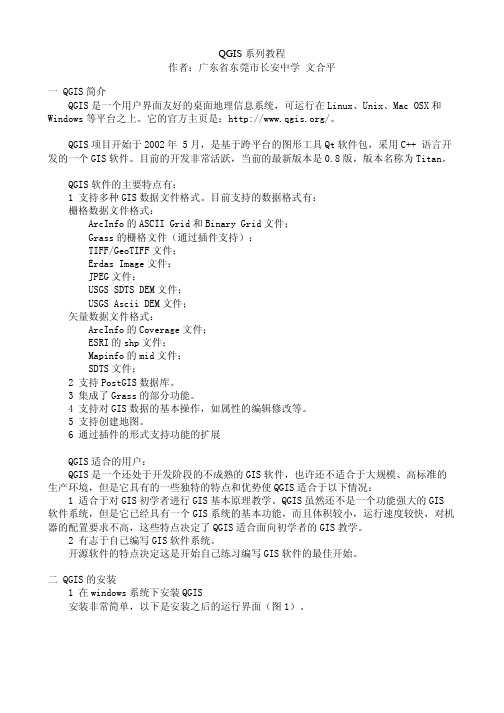
图2 1.1 建立矢量数据文件图层
选择 QGIS 软件的“图层”菜单(如上图 2),我们可以看到 QGIS 可以支持四种类型的 图层,点击第一项“添加一个矢量图层”就可以在文件系统中选择打开矢量 GIS 文件了。
图三
通过随后展现的子菜单我们可以看到当前的 QGIS 0.8 版本支持打开五种类型的矢量数 据文件类型(如图 3)。包括最常见的 ESRI 的 shape 文件格式和 Coverage 文件、MapInfo 的 mif 文件格式和当前逐渐流行的 GML 文件格式等。
所列图标的功能依次是: 开启图层编辑功能; 关闭图层编辑功能(同时保存所做的修改); 创建点; 创建线; 创建多边形; 增加节点; 删除节点; 移动节点; 删除所选择的图层元素;
编辑图层一般先点击“ ”图标, 或者在图层的属性列表上选择“允许编 辑”,图层中的节点就会出现标记符号, 然后开始进行相应的编辑了。
3 直接使用源码安装 QGIS 熟悉 Linux 的好手都喜欢自己直接下载源码、自己编译安装,但作者不推荐一般用户自 己编译安装 QGIS,因为 QGIS 的编译安装相当麻烦,最主要的麻烦在于自己编译安装 QGIS 的源码之前,还需要编译安装多个 QGIS 的依赖软件和依赖库,包括:Proj4、GEOS、 PostgreSQL、PostGIS、SQLite3、GDAL/OGR、GRASS、gdal-GRASS-plugins 和 QT4,每个软 件都需要下载、编译和安装,比较麻烦而且容易出错,所以不推荐一般用户采用。
当在 QGIS 菜单中选择
“添加 PostGIS 图层”的时
候,软件会弹出如右图 4 的
对话框,对话框上部的下拉
菜单中列举了你已经建立好
的 PostGIS 数据库连接。
Mapserver在桌面Linux下的实验环境搭建笔记
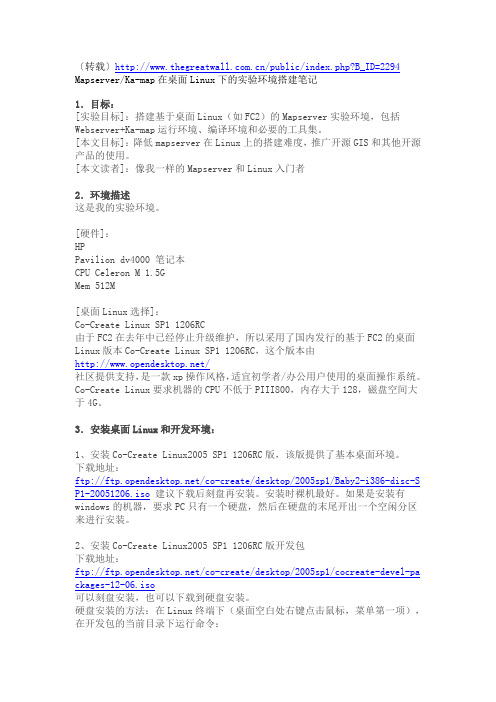
〔转载〕/public/index.php?B_ID=2294 Mapserver/Ka-map在桌面Linux下的实验环境搭建笔记1.目标:[实验目标]:搭建基于桌面Linux(如FC2)的Mapserver实验环境,包括Webserver+Ka-map运行环境、编译环境和必要的工具集。
[本文目标]:降低mapserver在Linux上的搭建难度,推广开源GIS和其他开源产品的使用。
[本文读者]:像我一样的Mapserver和Linux入门者2.环境描述这是我的实验环境。
[硬件]:HPPavilion dv4000 笔记本CPU Celeron M 1.5GMem 512M[桌面Linux选择]:Co-Create Linux SP1 1206RC由于FC2在去年中已经停止升级维护,所以采用了国内发行的基于FC2的桌面Linux版本Co-Create Linux SP1 1206RC,这个版本由/社区提供支持,是一款xp操作风格,适宜初学者/办公用户使用的桌面操作系统。
Co-Create Linux要求机器的CPU不低于PIII800,内存大于128,磁盘空间大于4G。
3.安装桌面Linux和开发环境:1、安装Co-Create Linux2005 SP1 1206RC版,该版提供了基本桌面环境。
下载地址:ftp:///co-create/desktop/2005sp1/Baby2-i386-disc-S P1-20051206.iso建议下载后刻盘再安装。
安装时裸机最好。
如果是安装有windows的机器,要求PC只有一个硬盘,然后在硬盘的末尾开出一个空闲分区来进行安装。
2、安装Co-Create Linux2005 SP1 1206RC版开发包下载地址:ftp:///co-create/desktop/2005sp1/cocreate-devel-pa ckages-12-06.iso可以刻盘安装,也可以下载到硬盘安装。
MapServer基本知识
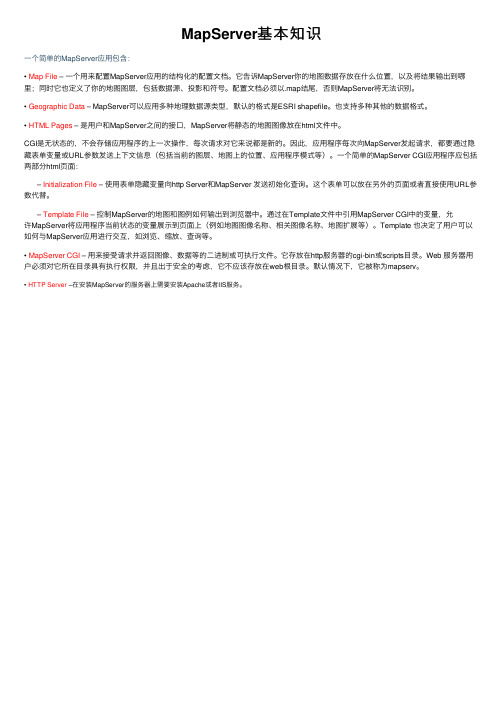
MapServer基本知识⼀个简单的MapServer应⽤包含:• Map File – ⼀个⽤来配置MapServer应⽤的结构化的配置⽂档。
它告诉MapServer你的地图数据存放在什么位置,以及将结果输出到哪⾥;同时它也定义了你的地图图层,包括数据源、投影和符号。
配置⽂档必须以.map结尾,否则MapServer将⽆法识别。
• Geographic Data – MapServer可以应⽤多种地理数据源类型,默认的格式是ESRI shapefile。
也⽀持多种其他的数据格式。
• HTML Pages – 是⽤户和MapServer之间的接⼝,MapServer将静态的地图图像放在html⽂件中。
CGI是⽆状态的,不会存储应⽤程序的上⼀次操作,每次请求对它来说都是新的。
因此,应⽤程序每次向MapServer发起请求,都要通过隐藏表单变量或URL参数发送上下⽂信息(包括当前的图层、地图上的位置、应⽤程序模式等)。
⼀个简单的MapServer CGI应⽤程序应包括两部分html页⾯:– Initialization File – 使⽤表单隐藏变量向http Server和MapServer 发送初始化查询。
这个表单可以放在另外的页⾯或者直接使⽤URL参数代替。
– Template File – 控制MapServer的地图和图例如何输出到浏览器中。
通过在Template⽂件中引⽤MapServer CGI中的变量,允许MapServer将应⽤程序当前状态的变量展⽰到页⾯上(例如地图图像名称、相关图像名称、地图扩展等)。
Template 也决定了⽤户可以如何与MapServer应⽤进⾏交互,如浏览、缩放、查询等。
• MapServer CGI – ⽤来接受请求并返回图像、数据等的⼆进制或可执⾏⽂件。
它存放在http服务器的cgi-bin或scripts⽬录。
Web 服务器⽤户必须对它所在⽬录具有执⾏权限,并且出于安全的考虑,它不应该存放在web根⽬录。
北京苍穹土地利用变更系统V3.0操作手册20160113资料

北京苍穹土地利用变更系统操作手册V3.0北京苍穹数码测绘有限公司二〇一五年一月目录北京苍穹土地利用变更系统 0目录 (1)1 二调数据转换及维护 (3)1.1 二调包转年初库及维护 (3)1.2 单位代码升级 (4)1.3 生成地类界线 (4)1.4 座落单位代码维护 (5)2 数据变更 (5)2.1 变更参数设置 (5)2.2 比对设置 (5)2.3 数据变更 (6)3 统计年末台账 (16)4 增量库提取及维护 (17)4.1 比对分析 (17)4.2 增量库维护 (18)4.3 增量包预检 (19)5 增量成果输出 (19)6 辅助功能 (20)6.1 增量数据更新年初库 (20)6.2 根据增量包更新年末界线 (20)6.3 二调报表输出 (21)6.4 二调标准格式输出 (21)6.5 数据库转元数据 (22)6.6增量包生成调查表 (22)6.7土地变更调查成果包输出 (23)7 附录 (23)7.1 BSM 标识码 (23)7.2 地类变化概念 (23)7.3 变更编号 (24)7.4 数据提交后的不变性 (24)7.5 数据变更的类型 (24)提示:1.土地利用变更系统是在新平台上开发的,老版本的苍穹标准库直接用不了,需要转换成AE国家标准二调库进行二调包转年初库及维护得到年初库。
2.试用版程序使用前请先注册程序①动态库注册:单击任何一个dll文件,右键,选择打开方式C:\WINDOWS\system32\regsvr32文件,并勾选始终用这个程序打开这种类型的文件。
注:XP系统可以一次性打开所有dll文件,WIN7系统下可以一次性最多打开15个dll文件;②批量注册:双击程序目录下的对应的ARCGIS版本的Dll_Reg注册文件。
以上两种方式可以任选一种,软件注册方式通用于苍穹系列软件。
3.数据变更涉及到的功能基本上都在数据变更菜单下:1 二调数据转换及维护1.1 二调包转年初库及维护支持3种标准格式数据的导入(mdb、shp、vct);选择源库:必须选择二调包文件夹那一级别,不能选到具体矢量数据的所在位置。
(Linux环境)Apache配置WebLogic集群分发
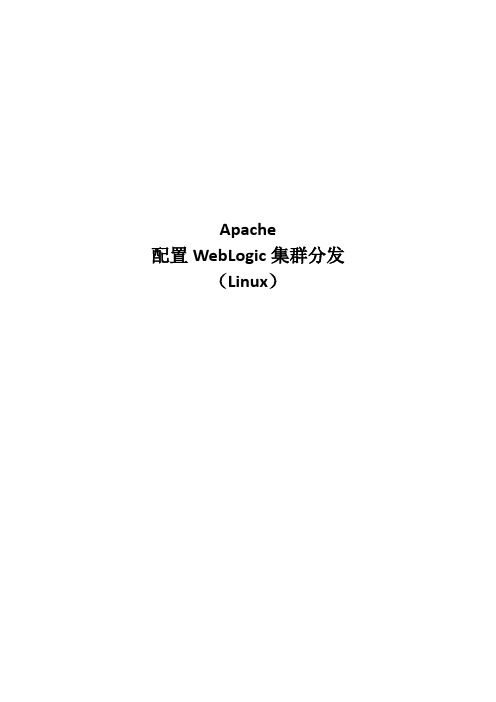
Apache配置WebLogic集群分发(Linux)目录一、安装Apache (2)1、拷贝apache安装包至linux文件夹 (2)2、解压apache安装包 (3)3、创建apache安装目录 (3)4、配置检查 (3)5、编译 (3)6、安装 (3)二、检查Apache是否安装成功 (3)1、启动Apache (3)2、检查Appache服务是否启动 (3)三、Apache分发配置 (3)四、重启apache服务 (5)五、常见问题 (5)六、注意事项 (5)一、安装Apache1、拷贝apache安装包至linux文件夹httpd-2.2.17.tar.gz放至/data/soft-installer目录2、解压apache安装包[root@localhost ~]# cd /data/soft-installer[root@localhost soft-installer]# tar zxvf httpd-2.2.17.tar.gz3、创建apache安装目录[root@localhost sof-installer]#cd /root/soft/httpd-2.2.17[***********************.17]#mkdir/usr/local/apache4、配置检查[root@localhost httpd-2.2.17]#./configure --prefix=/usr/local/apache --enable-so5、编译[***********************.17]#make6、安装[***********************.17]#makeinstall二、检查Apache是否安装成功1、启动Apache[***********************.17]#/usr/local/apache/bin/apachectlstart2、检查Appache服务是否启动[***********************.17]#ps-ef|grep httpd或者打开浏览器,在地址栏输入“http://ip”出现“It works!”或apache图标的漂亮界面,说明apache安装成功!三、Apache分发配置1、拷贝weblogic mod_wl_22.so至/usr/local/apache/modules/目录切换至weblogic目录如:/root/Oracle/Middleware/wlserver_10.3/server/plugin/linux/x86_64路径,找到mod_wl_22.so文件将文件复制到/usr/local/apache/modules目录2、配置httpd.confA、编辑Apache配置文件:[***********************.17]#vi/usr/local/apache/conf/httpd.confB、加载weblogic_module配置输入/LoadModule后回车,找到下面文本中的黑色字体部分,并添加黄色标记的语句:# LoadModule foo_module modules/mod_foo.soLoadModule weblogic_module modules/mod_wl_22.soC、配置监听端口#Listen 12.34.56.78:80Listen 9085D、配置分发节点IP及端口httpd.conf文件末尾添加如下语句,标红部分为分发节点IP和端口配置(需根据具体需要自行调整)四、重启apache服务[***********************.17]#/usr/local/apache/bin/apachectlrestart五、常见问题1、ntax error on line 202 of /etc/httpd/conf/httpd.conf: Cannot load/etc/httpd/modules/mod_wl_22.so into server: libstdc++.so.5: cannotopen shared object file: No such file or directory(modules是链接形式才出现)解决办法:安装compat-libstdc++-33-3.2.3-69.el6.x86_64.rpm程序A、将compat-libstdc++-33-3.2.3-69.el6.x86_64.rpm拷贝至/data/soft-installerB、cd /data/soft-installerC、rpm -ivh compat-libstdc++-33-3.2.3-69.el6.x86_64.rpm六、注意事项1、httpd.conf文件中配置的监听端口不能冲突2、httpd.conf 末尾添加语句,配置节点信息,需要配置成对应的IP和端口信息。
windows环境下MapServer和MapLab的配置
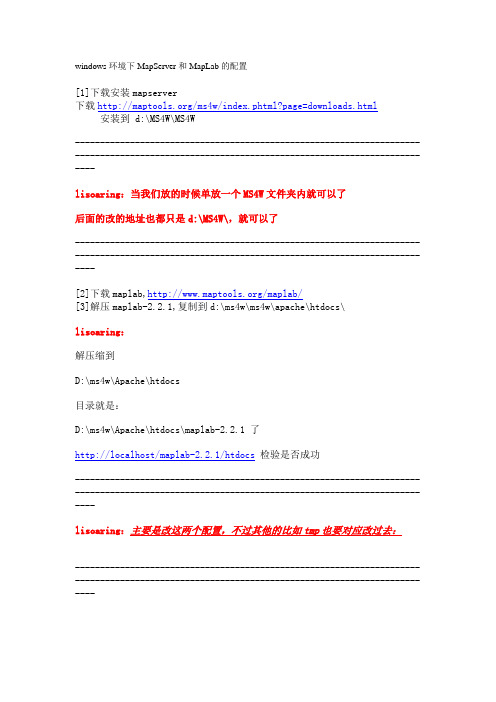
windows环境下MapServer和MapLab的配置[1]下载安装mapserver下载/ms4w/index.phtml?page=downloads.html 安装到 d:\MS4W\MS4W----------------------------------------------------------------------------------------------------------------------------------------------lisoaring:当我们放的时候单放一个MS4W文件夹内就可以了后面的改的地址也都只是d:\MS4W\,就可以了----------------------------------------------------------------------------------------------------------------------------------------------[2]下载maplab,/maplab/[3]解压maplab-2.2.1,复制到d:\ms4w\ms4w\apache\htdocs\lisoaring:解压缩到D:\ms4w\Apache\htdocs目录就是:D:\ms4w\Apache\htdocs\maplab-2.2.1 了http://localhost/maplab-2.2.1/htdocs检验是否成功----------------------------------------------------------------------------------------------------------------------------------------------lisoaring:主要是改这两个配置,不过其他的比如tmp也要对应改过去:--------------------------------------------------------------------------------------------------------------------------------------------------------------------------------------------------------------------------------------------------------------------------------------------然后配置app_path:改成maplab的路径:mapscript_module:改成:php_mapscript.dll----------------------------------------------------------------------------------------------------------------------------------------------改路径的时候:注意文件夹的这个"/"和”\",一定要写成“/"Note: All paths MUST contain forward slashes (/) only. Backslashes (\) are NOT supported!我的配置后:在mapedit页以及后面那几个页的[4]在浏览器打开http://localhost/maplab-2.2.1/htdocs/,可以看到:[4]点击配置maplab,如下图所示:[5]配置maplab,mapbrowser,mapedit[6]查看配置,如果都是绿色的“√”,就说明使正确的最可能不好配置的就是mapscript的配置了。
装环境
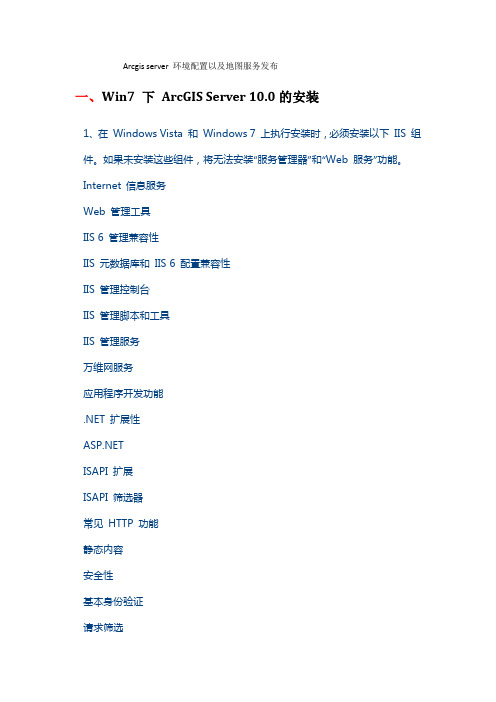
Arcgis server 环境配置以及地图服务发布一、Win7 下ArcGIS Server 10.0的安装1、在Windows Vista 和Windows 7 上执行安装时,必须安装以下IIS 组件。
如果未安装这些组件,将无法安装“服务管理器”和“Web 服务”功能。
Internet 信息服务Web 管理工具IIS 6 管理兼容性IIS 元数据库和IIS 6 配置兼容性IIS 管理控制台IIS 管理脚本和工具IIS 管理服务万维网服务应用程序开发功能.NET 扩展性ISAPI 扩展ISAPI 筛选器常见HTTP 功能静态内容安全性基本身份验证请求筛选Windows 身份验证具体配置安装如下:打开控制面板---程序---打开程序和功能在弹出的窗口按照上面配置要求将需要的项都选择上(√上),(有的需要展开)(下面只是截图的一部分,其他自己去勾上,否则无法正常安装那就是自己的问题了哦!!!然后确定,iis安装成功!接下来进行iis配置:右击计算机----管理----打开Internet信息服务管理器然后双击打开Asp:浏览器中输入http://localhost,出现如下界面,则IIS安装成功!至此,IIS配置完成!!!!ArcGisServer10安装阶段:(VS2010 最好先装)第一步:打开镜像文件中的ESRI.EXE:(直接双击即可,不解压也行)第二步:如下图所示操作,单击红色框中的安装:(因为是安装.net环境的,所以选择此项,其他环境类似)第三步:安装完成后的配置:(关键)点击确定。
第四步:后面几个步骤默认安装直接点击下一步:(需要更改的地方我会提示):第五步:默认配置:点击下一步:第六步:设置账户名和密码:(需要手动设置密码,自己熟悉的,呵呵)第六步:设置GIS服务器目录:可以自己选择,然后下一步第七步:默认配置,下一步:第八步:查看服务器配置摘要(确定后点击安装)第九步:继续下一步:第十步:软件权限向导界面:选择第三项:导入许可文件:ecp格式的:第十一步:授权向导界面:单击完成:第十二步:服务器安装后配置界面:单击完成!然后弹出提示界面:(安装即将完成)安装完成!单击确定弹出后续配置web界面:第十三步:进行用户组权限配置:(重要)右击计算机---管理,打开计算机管理界面,选择本地用户于组,点击“组”然后分别为Administrators、agsadmin、agsusers三个组添加成员:如:Administrators:右击该组,然后选择“属性”然后点击添加添加如下成员:Agsadmin组一样:Agsusers组也一样:好了,配置到此完成!然后重启电脑,(否则后面创建地图服务可能会出错)来体验ArcGis Server10的地图服务功能吧!简单服务演示:打开ArcCatalog:双击“添加ArcGIS Server节点”:添加Server Object节点:弹出对话框:选择管理GIS服务,下一步:在常规对话框中设置服务器url及主机名称:然后将服务器URL及主机名称中的services改成自己的主机的名字,就ok!(两个地方都需要改)点击完成后就可以看到新添加的Server Object节点了:然后打开ArcMap我们创建一副地图:(随便都可以,用来测试服务可不可用):将其命名为“server.mxd”保存。
开源GIS软件MapServer介绍三维Gis
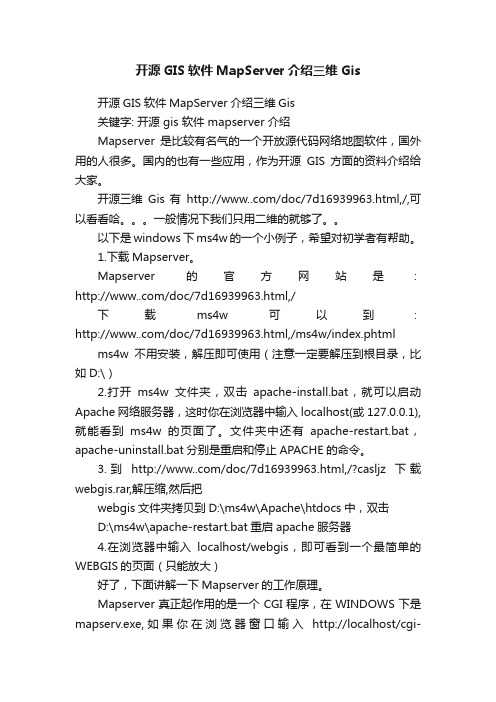
开源GIS软件MapServer介绍三维Gis开源GIS软件MapServer介绍三维Gis关键字: 开源 gis 软件 mapserver 介绍Mapserver是比较有名气的一个开放源代码网络地图软件,国外用的人很多。
国内的也有一些应用,作为开源GIS方面的资料介绍给大家。
开源三维Gis 有/doc/7d16939963.html,/,可以看看哈。
一般情况下我们只用二维的就够了。
以下是windows下ms4w的一个小例子,希望对初学者有帮助。
1.下载Mapserver。
Mapserver的官方网站是:/doc/7d16939963.html,/下载ms4w可以到:/doc/7d16939963.html,/ms4w/index.phtml ms4w不用安装,解压即可使用(注意一定要解压到根目录,比如D:\)2.打开ms4w文件夹,双击apache-install.bat,就可以启动Apache网络服务器,这时你在浏览器中输入localhost(或127.0.0.1),就能看到ms4w的页面了。
文件夹中还有apache-restart.bat,apache-uninstall.bat分别是重启和停止APACHE的命令。
3.到/doc/7d16939963.html,/?casljz 下载webgis.rar,解压缩,然后把webgis文件夹拷贝到D:\ms4w\Apache\htdocs中,双击D:\ms4w\apache-restart.bat重启apache服务器4.在浏览器中输入localhost/webgis,即可看到一个最简单的WEBGIS的页面(只能放大)好了,下面讲解一下Mapserver的工作原理。
Mapserver真正起作用的是一个CGI程序,在WINDOWS下是mapserv.exe,如果你在浏览器窗口输入http://localhost/cgi-bin/mapserv.exe,得到:“No query information to decode. QUERY_STRING is set, but empty.”,说明你的mapserver已经能干活啦。
mapserver map_saver用法
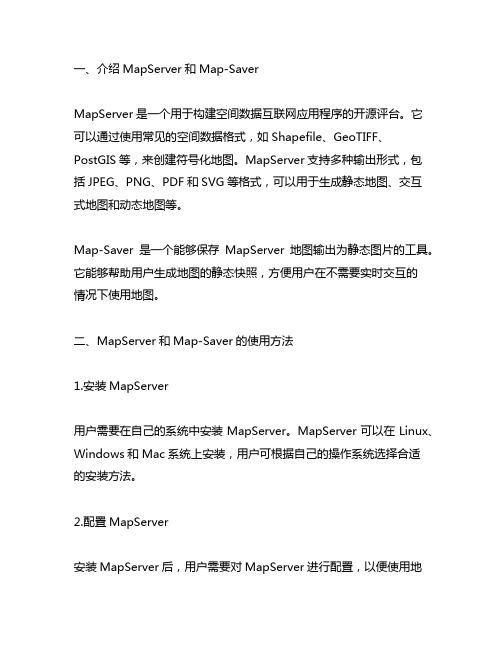
一、介绍MapServer和Map-SaverMapServer是一个用于构建空间数据互联网应用程序的开源评台。
它可以通过使用常见的空间数据格式,如Shapefile、GeoTIFF、PostGIS等,来创建符号化地图。
MapServer支持多种输出形式,包括JPEG、PNG、PDF和SVG等格式,可以用于生成静态地图、交互式地图和动态地图等。
Map-Saver是一个能够保存MapServer地图输出为静态图片的工具。
它能够帮助用户生成地图的静态快照,方便用户在不需要实时交互的情况下使用地图。
二、MapServer和Map-Saver的使用方法1.安装MapServer用户需要在自己的系统中安装MapServer。
MapServer可以在Linux、Windows和Mac系统上安装,用户可根据自己的操作系统选择合适的安装方法。
2.配置MapServer安装MapServer后,用户需要对MapServer进行配置,以便使用地图数据和生成地图。
用户可以在MapServer的冠方全球信息站上找到详细的配置教程和文档,按照指引进行配置。
3.创建MapServer地图文件用户需要创建一个MapServer地图文件,该文件描述了地图数据的来源、投影方式、符号化样式等元素。
用户可以使用文本编辑器创建地图文件,也可以使用MapServer提供的地图文件编辑工具来快速配置地图文件。
4.启动MapServer配置好地图文件后,用户需要启动MapServer,让其运行起来。
用户可以通过命令行或者图形界面方式启动MapServer,具体的操作方式可参考MapServer的冠方文档。
5.访问MapServer服务一旦MapServer运行起来,用户就可以通过Web浏览器或者其他应用程序访问MapServer服务,获取生成的地图数据。
用户可以根据自己的需求,选择合适的输出格式和地图范围,获取所需的地图快照。
6.安装Map-SaverMap-Saver是一个用于保存MapServer地图输出为静态图片的工具。
qgis server 使用手册
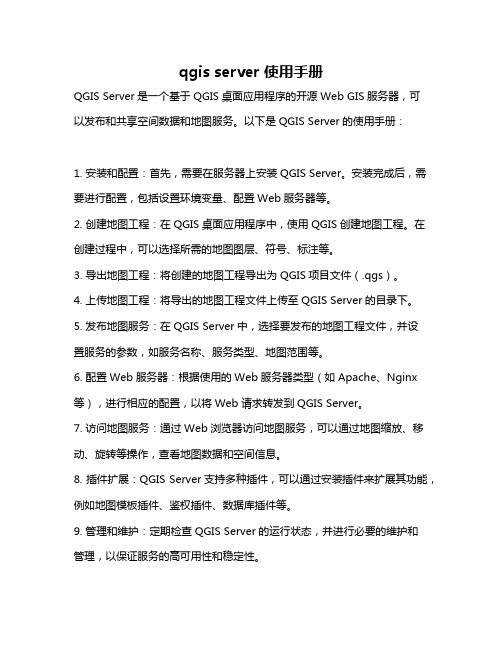
qgis server 使用手册
QGIS Server是一个基于QGIS桌面应用程序的开源Web GIS服务器,可
以发布和共享空间数据和地图服务。
以下是QGIS Server的使用手册:
1. 安装和配置:首先,需要在服务器上安装QGIS Server。
安装完成后,需要进行配置,包括设置环境变量、配置Web服务器等。
2. 创建地图工程:在QGIS桌面应用程序中,使用QGIS创建地图工程。
在创建过程中,可以选择所需的地图图层、符号、标注等。
3. 导出地图工程:将创建的地图工程导出为QGIS项目文件(.qgs)。
4. 上传地图工程:将导出的地图工程文件上传至QGIS Server的目录下。
5. 发布地图服务:在QGIS Server中,选择要发布的地图工程文件,并设
置服务的参数,如服务名称、服务类型、地图范围等。
6. 配置Web服务器:根据使用的Web服务器类型(如Apache、Nginx 等),进行相应的配置,以将Web请求转发到QGIS Server。
7. 访问地图服务:通过Web浏览器访问地图服务,可以通过地图缩放、移动、旋转等操作,查看地图数据和空间信息。
8. 插件扩展:QGIS Server支持多种插件,可以通过安装插件来扩展其功能,例如地图模板插件、鉴权插件、数据库插件等。
9. 管理和维护:定期检查QGIS Server的运行状态,并进行必要的维护和
管理,以保证服务的高可用性和稳定性。
以上是QGIS Server的使用手册,通过按照这些步骤操作,可以轻松地发布和共享空间数据和地图服务。
MapServer的安装和使用
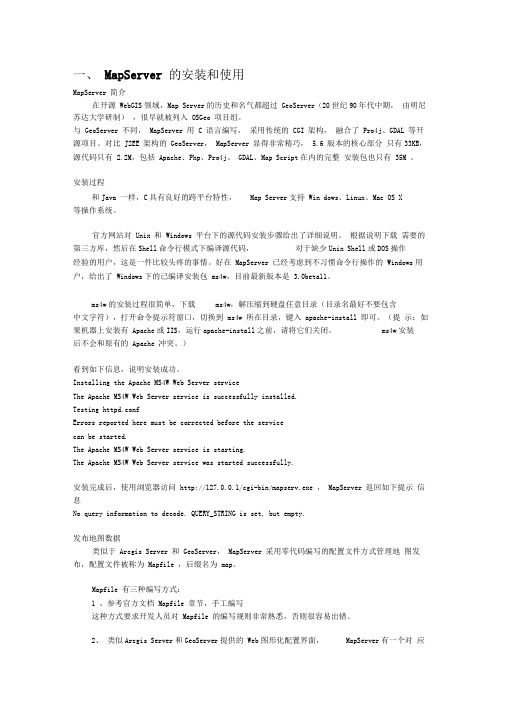
一、MapServer 的安装和使用MapServer 简介在开源WebGIS领域,Map Server的历史和名气都超过GeoServer(20世纪90年代中期,由明尼苏达大学研制),很早就被列入OSGeo 项目组。
与GeoServer 不同,MapServer 用 C 语言编写,采用传统的CGI 架构,融合了Pro4j、GDAL 等开源项目。
对比J2EE 架构的GeoServer,MapServer 显得非常精巧, 5.6 版本的核心部分只有33KB,源代码只有 2.2M,包括Apache、Php、Pro4j、GDAL、Map Script在内的完整安装包也只有35M 。
安装过程和Java 一样,C具有良好的跨平台特性,Map Server支持Win dows、Linux、Mac OS X等操作系统。
官方网站对Unix 和Windows 平台下的源代码安装步骤给出了详细说明。
根据说明下载需要的第三方库,然后在Shell命令行模式下编译源代码,对于缺少Unix Shell或DOS操作经验的用户,这是一件比较头疼的事情。
好在MapServer 已经考虑到不习惯命令行操作的Windows用户,给出了Windows下的已编译安装包ms4w,目前最新版本是 3.0beta11。
ms4w的安装过程很简单,下载ms4w,解压缩到硬盘任意目录(目录名最好不要包含中文字符),打开命令提示符窗口,切换到ms4w 所在目录,键入apache-install 即可。
(提示:如果机器上安装有Apache或IIS,运行apache-install之前,请将它们关闭。
ms4w安装后不会和原有的Apache 冲突。
)看到如下信息,说明安装成功。
Installing the Apache MS4W Web Server serviceThe Apache MS4W Web Server service is successfully installed.Testing httpd.confErrors reported here must be corrected before the servicecan be started.The Apache MS4W Web Server service is starting.The Apache MS4W Web Server service was started successfully.安装完成后,使用浏览器访问http://127.0.0.1/cgi-bin/mapserv.exe ,MapServer 返回如下提示信息No query information to decode. QUERY_STRING is set, but empty.发布地图数据类似于Arcgis Server 和GeoServer,MapServer 采用零代码编写的配置文件方式管理地图发布,配置文件被称为Mapfile ,后缀名为map。
MapServer配置以及地图发布(Windows下)
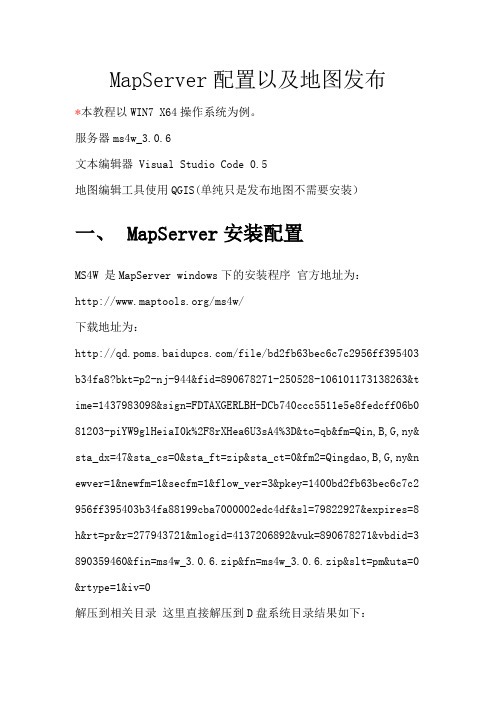
MapServer配置以及地图发布*本教程以WIN7 X64操作系统为例。
服务器ms4w_3.0.6文本编辑器 Visual Studio Code 0.5地图编辑工具使用QGIS(单纯只是发布地图不需要安装)一、MapServer安装配置MS4W 是MapServer windows下的安装程序官方地址为:/ms4w/下载地址为:/file/bd2fb63bec6c7c2956ff395403 b34fa8?bkt=p2-nj-944&fid=890678271-250528-106101173138263&t ime=1437983098&sign=FDTAXGERLBH-DCb740ccc5511e5e8fedcff06b0 81203-piYW9glHeiaI0k%2F8rXHea6U3sA4%3D&to=qb&fm=Qin,B,G,ny& sta_dx=47&sta_cs=0&sta_ft=zip&sta_ct=0&fm2=Qingdao,B,G,ny&n ewver=1&newfm=1&secfm=1&flow_ver=3&pkey=1400bd2fb63bec6c7c2 956ff395403b34fa88199cba7000002edc4df&sl=79822927&expires=8 h&rt=pr&r=277943721&mlogid=4137206892&vuk=890678271&vbdid=3 890359460&fin=ms4w_3.0.6.zip&fn=ms4w_3.0.6.zip&slt=pm&uta=0 &rtype=1&iv=0解压到相关目录这里直接解压到D盘系统目录结果如下:Win+R 输入CMD回车进入到命令行模式:切换到目录命令行进入解压后的目录执行 apache-installNET HELPMSG 3457呵呵 80端口被占用了修改apache 端口为8001(因为我的81端口也占了这里根据个人喜好而定)端口修改为8001或者其他未占用的端口重新执行apache-install安装就OK了在IE或其他浏览器中访问http://127.0.0.1:8001/cgi-bin/mapserv.exeNo query information to decode. QUERY_STRING is set, but empty. 说明安装成功但是地图是空的接下来就要进行配置二、地图配置(MapFile配置)进入D:\ms4w\tools\gdal-ogr执行ogrinfo D:\ms4w\data\yulinogrinfo信息主要用于查看shpfile等图层信息拷贝D:\ms4w\Apache\cgi-bin目录下的gdal19.dll,xerces-c_3_1.dll libexpat.dll libpq.dlllti_lidar_dsdk.dll lti_dsdk.dll cfitsio.dll netcdf.dll geotiff.dll libtiff.dll zlibwapi.dll jbig1.dll spatialite.dll proj.dll geos_c.dll iconv.dll libmysql.dll hdf5dll.dll szlibdll.dll libcurl.dll libeay32.dll ssleay32.dll FileGDBAPI.dll 具体直接在根目录下搜到D:\ms4w\tools\gdal-ogr拷贝完成后再执行ogrinfo D:\ms4w\Apache\htdocs\YLData ogrinfo D:\ms4w\Apache\htdocs\YLDataqgis下载地址/qgis/win32/QGIS-OSGeo4W-2.8.2-1-S etup-x86_64.exe下载完qgis后配置好相关图层信息发布一个图层Shp文件放到D:\ms4w\Apache\htdocs\YLDataSHP文件如上图在D:\ms4w\Apache\htdocs目录下新建yulin.map内容如下:MAP # Start of MAP objectNAME "china-region"STATUS ONIMAGECOLOR 255 255 255 #图层背景颜色SIZE 800 600 #尺寸#EXTENT 70 10 140 60EXTENT 87.85 31.17 129.58 53.23 #地图视野范围SHAPEPATH "YLData" #shp文件目录LAYERNAME "qxj" #图层名称URL中用METADATA"DESCRIPTION" "qxj"ENDTYPE LINE #图层类型POINT LINE ???STATUS OFFDATA "QXJ_region" #对应的shp图层名CLASS #样式NAME "Graticule"STYLECOLOR 0 0 0ENDENDEND # LayerEND # End of MAP object and map file保存后在浏览器中输入如下内容:http://127.0.0.1:8001/cgi-bin/mapserv.exe?MAP=D:/ms4w/Apach e/htdocs/yulin.map&layers=qxj&styles=&service=WMS&mode=map& width=256&format=image%2Fpng&request=GetMap&height=256&srs= EPSG%3A4326&version=1.1.1URL中注意layers为需要获取的图层 Map.map文件对应的路径这是地图就会自动加载出来:*注意MapServer不支持中文名称路径所以shp文件名称以及存放路径不要使用中文。
qgisserver下载与安装(windows系统)
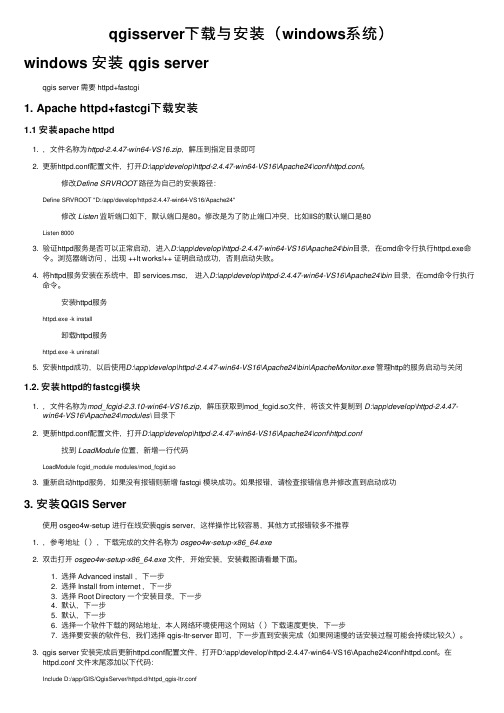
qgisserver下载与安装(windows系统)windows 安装 qgis serverqgis server 需要 httpd+fastcgi1. Apache httpd+fastcgi下载安装1.1 安装apache httpd1. ,⽂件名称为httpd-2.4.47-win64-VS16.zip,解压到指定⽬录即可2. 更新httpd.conf配置⽂件,打开D:\app\develop\httpd-2.4.47-win64-VS16\Apache24\conf\httpd.conf。
修改Define SRVROOT路径为⾃⼰的安装路径:Define SRVROOT "D:/app/develop/httpd-2.4.47-win64-VS16/Apache24"修改Listen监听端⼝如下,默认端⼝是80。
修改是为了防⽌端⼝冲突,⽐如IIS的默认端⼝是80Listen 80003. 验证httpd服务是否可以正常启动,进⼊D:\app\develop\httpd-2.4.47-win64-VS16\Apache24\bin⽬录,在cmd命令⾏执⾏httpd.exe命令。
浏览器端访问,出现 ++It works!++ 证明启动成功,否则启动失败。
4. 将httpd服务安装在系统中,即 services.msc,进⼊D:\app\develop\httpd-2.4.47-win64-VS16\Apache24\bin⽬录,在cmd命令⾏执⾏命令。
安装httpd服务httpd.exe -k install卸载httpd服务httpd.exe -k uninstall5. 安装httpd成功,以后使⽤D:\app\develop\httpd-2.4.47-win64-VS16\Apache24\bin\ApacheMonitor.exe管理http的服务启动与关闭1.2. 安装httpd的fastcgi模块1. ,⽂件名称为mod_fcgid-2.3.10-win64-VS16.zip,解压获取到mod_fcgid.so⽂件,将该⽂件复制到D:\app\develop\httpd-2.4.47-win64-VS16\Apache24\modules\⽬录下2. 更新httpd.conf配置⽂件,打开D:\app\develop\httpd-2.4.47-win64-VS16\Apache24\conf\httpd.conf找到LoadModule位置,新增⼀⾏代码LoadModule fcgid_module modules/mod_fcgid.so3. 重新启动httpd服务,如果没有报错则新增 fastcgi 模块成功。
- 1、下载文档前请自行甄别文档内容的完整性,平台不提供额外的编辑、内容补充、找答案等附加服务。
- 2、"仅部分预览"的文档,不可在线预览部分如存在完整性等问题,可反馈申请退款(可完整预览的文档不适用该条件!)。
- 3、如文档侵犯您的权益,请联系客服反馈,我们会尽快为您处理(人工客服工作时间:9:00-18:30)。
QGIS MapServer基于IIS及Apache服务器配置手册1. IIS 6.0配置步骤: (3)1.1. 安装Fastcgi IIS扩展程序 (3)1.2. 配置IIS扩展映射 (3)1.3. 配置MAP FCGI程序 (4)1.4. 修改FCGI配置文件 (5)1.5. 测试程序 (5)1.1.1. 最简单的测试程序(gisServerIIS.html) (5)1.1.2. 基于OpenLayers的测试程序 (5)2. Apache服务器配置 (6)1.IIS 6.0配置步骤:1.1.安装Fastcgi IIS扩展程序安装文件:fcgisetup_1.5_rtw_x86.msi安装完后应该在:C:\WINDOWS\system32\inetsrv 目录下找到fcgiext.dll,fcgiext.ini,fcgiconfig.js等文件1.2.配置IIS扩展映射步骤详见下图:1.3.配置MAP FCGI程序修改程序(qgis_mapserv.exe.fcgi)所在目录的执行权限为“脚本和可执行文件”:1.4.修改FCGI配置文件修改文件(C:\WINDOWS\system32\inetsrv\fcgiext.ini):在文件中增加以下内容(参数值可根据需要修改):[Types]fcgi=FCGI[FCGI]ExePath=C:\Inetpub\wwwroot\project\qgis_mapserv.exe.fcgi;EnvironmentVars=FcgidMinProcessesPerClass:0,FcgidIdleScanInterval:1,FcgidProcessLifeTime:10 0MaxInstances=8RequestTimeout=3601.5.测试程序注意:1、WMS Server端只处理UTF8编码请求,所在在客户端脚本中增加以下内容:<meta http-equiv="Content-Type" content="text/html; charset=UTF-8"/>2、WMS1.3的BBOX坐标为倒置,即纬度在前;1.1.1.最简单的测试程序(gisServerIIS.html)功能:完成一次WMS请求代码中以下内容请根据不同机器及应用的情况进行修改:action="/project/qgis_mapserv.exe.fcgi"<input type="hidden" name="LAYERS" value="xxx行政区划"><input type="hidden" name="BBOX" value="29.494642,87.140300,54.824900,136.763000">1.1.2.基于OpenLayers的测试程序请参见OpenLayers openlayers\examples\ wms-fjmiis.html功能:可进行地图浏览操作,平衡,放大,缩小2.Apache服务器配置基于Apache/2.2.21版本修改:D:\ms4w\Apache\conf\ httpd.conf文件,详细修改请参见以下红色部分内容(修改后需重启Apache服务器)[httpd.conf范例]## This is the main Apache HTTP server configuration file. It contains the# configuration directives that give the server its instructions.# See <URL:/docs/2.2> for detailed information.# In particular, see# <URL:/docs/2.2/mod/directives.html># for a discussion of each configuration directive.## Do NOT simply read the instructions in here without understanding# what they do. They're here only as hints or reminders. If you are unsure# consult the online docs. You have been warned.## Configuration and logfile names: If the filenames you specify for many# of the server's control files begin with "/" (or "drive:/" for Win32), the# server will use that explicit path. If the filenames do *not* begin# with "/", the value of ServerRoot is prepended -- so "logs/foo.log"# with ServerRoot set to "d:/ms4w/Apache" will be interpreted by the# server as "d:/ms4w/Apache/logs/foo.log".## NOTE: Where filenames are specified, you must use forward slashes# instead of backslashes (e.g., "c:/apache" instead of "c:\apache").# If a drive letter is omitted, the drive on which httpd.exe is located# will be used by default. It is recommended that you always supply# an explicit drive letter in absolute paths to avoid confusion.## ServerRoot: The top of the directory tree under which the server's# configuration, error, and log files are kept.## Do not add a slash at the end of the directory path. If you point# ServerRoot at a non-local disk, be sure to point the LockFile directive# at a local disk. If you wish to share the same ServerRoot for multiple# httpd daemons, you will need to change at least LockFile and PidFile.#ServerRoot "d:/ms4w/Apache"## Listen: Allows you to bind Apache to specific IP addresses and/or# ports, instead of the default. See also the <VirtualHost># directive.## Change this to Listen on specific IP addresses as shown below to# prevent Apache from glomming onto all bound IP addresses.##Listen 12.34.56.78:80Listen 8089## Dynamic Shared Object (DSO) Support## To be able to use the functionality of a module which was built as a DSO you # have to place corresponding `LoadModule' lines at this location so the# directives contained in it are actually available _before_ they are used.# Statically compiled modules (those listed by `httpd -l') do not need# to be loaded here.## Example:# LoadModule foo_module modules/mod_foo.so#LoadModule actions_module modules/mod_actions.soLoadModule alias_module modules/mod_alias.soLoadModule asis_module modules/mod_asis.soLoadModule auth_basic_module modules/mod_auth_basic.so#LoadModule auth_digest_module modules/mod_auth_digest.so#LoadModule authn_alias_module modules/mod_authn_alias.so#LoadModule authn_anon_module modules/mod_authn_anon.so#LoadModule authn_dbd_module modules/mod_authn_dbd.so#LoadModule authn_dbm_module modules/mod_authn_dbm.so LoadModule authn_default_module modules/mod_authn_default.so LoadModule authn_file_module modules/mod_authn_file.so#LoadModule authnz_ldap_module modules/mod_authnz_ldap.so#LoadModule authz_dbm_module modules/mod_authz_dbm.so LoadModule authz_default_module modules/mod_authz_default.so LoadModule authz_groupfile_module modules/mod_authz_groupfile.so LoadModule authz_host_module modules/mod_authz_host.so#LoadModule authz_owner_module modules/mod_authz_owner.so LoadModule authz_user_module modules/mod_authz_user.so LoadModule autoindex_module modules/mod_autoindex.so#LoadModule cache_module modules/mod_cache.so#LoadModule cern_meta_module modules/mod_cern_meta.so LoadModule cgi_module modules/mod_cgi.soLoadModule charset_lite_module modules/mod_charset_lite.so#LoadModule dav_module modules/mod_dav.so#LoadModule dav_fs_module modules/mod_dav_fs.so#LoadModule dav_lock_module modules/mod_dav_lock.so#LoadModule dbd_module modules/mod_dbd.so#LoadModule deflate_module modules/mod_deflate.so LoadModule dir_module modules/mod_dir.so#LoadModule disk_cache_module modules/mod_disk_cache.so#LoadModule dumpio_module modules/mod_dumpio.so LoadModule env_module modules/mod_env.so#LoadModule expires_module modules/mod_expires.so#LoadModule ext_filter_module modules/mod_ext_filter.so#LoadModule file_cache_module modules/mod_file_cache.so#LoadModule filter_module modules/mod_filter.so#LoadModule headers_module modules/mod_headers.so#LoadModule ident_module modules/mod_ident.so#LoadModule imagemap_module modules/mod_imagemap.so LoadModule include_module modules/mod_include.so#LoadModule info_module modules/mod_info.soLoadModule isapi_module modules/mod_isapi.so#LoadModule ldap_module modules/mod_ldap.so#LoadModule logio_module modules/mod_logio.soLoadModule log_config_module modules/mod_log_config.so#LoadModule log_forensic_module modules/mod_log_forensic.so#LoadModule mem_cache_module modules/mod_mem_cache.so LoadModule mime_module modules/mod_mime.so#LoadModule mime_magic_module modules/mod_mime_magic.so LoadModule negotiation_module modules/mod_negotiation.so#LoadModule proxy_module modules/mod_proxy.so#LoadModule proxy_ajp_module modules/mod_proxy_ajp.so#LoadModule proxy_balancer_module modules/mod_proxy_balancer.so #LoadModule proxy_connect_module modules/mod_proxy_connect.so #LoadModule proxy_ftp_module modules/mod_proxy_ftp.so#LoadModule proxy_http_module modules/mod_proxy_http.so#LoadModule proxy_scgi_module modules/mod_proxy_scgi.so#LoadModule reqtimeout_module modules/mod_reqtimeout.so#LoadModule rewrite_module modules/mod_rewrite.so LoadModule setenvif_module modules/mod_setenvif.so#LoadModule speling_module modules/mod_speling.so#LoadModule ssl_module modules/mod_ssl.so#LoadModule status_module modules/mod_status.so#LoadModule substitute_module modules/mod_substitute.so#LoadModule unique_id_module modules/mod_unique_id.so#LoadModule userdir_module modules/mod_userdir.so#LoadModule usertrack_module modules/mod_usertrack.so#LoadModule version_module modules/mod_version.so#LoadModule vhost_alias_module modules/mod_vhost_alias.so LoadModule fcgid_module modules/mod_fcgid.so#LoadModule fcgid_module fcgi-bin/qgis_mapserv.fcgi<IfModule !mpm_netware_module><IfModule !mpm_winnt_module>## If you wish httpd to run as a different user or group, you must run# httpd as root initially and it will switch.## User/Group: The name (or #number) of the user/group to run httpd as. # It is usually good practice to create a dedicated user and group for# running httpd, as with most system services.#User daemonGroup daemon</IfModule></IfModule># 'Main' server configuration## The directives in this section set up the values used by the 'main'# server, which responds to any requests that aren't handled by a# <VirtualHost> definition. These values also provide defaults for# any <VirtualHost> containers you may define later in the file.## All of these directives may appear inside <VirtualHost> containers,# in which case these default settings will be overridden for the# virtual host being defined.### ServerAdmin: Your address, where problems with the server should be # e-mailed. This address appears on some server-generated pages, such # as error documents. e.g. admin@#ServerAdmin admin@## ServerName gives the name and port that the server uses to identify itself. # This can often be determined automatically, but we recommend you specify # it explicitly to prevent problems during startup.## If your host doesn't have a registered DNS name, enter its IP address here. ##ServerName :80## DocumentRoot: The directory out of which you will serve your# documents. By default, all requests are taken from this directory, but# symbolic links and aliases may be used to point to other locations.#DocumentRoot "d:/ms4w/Apache/htdocs"## Each directory to which Apache has access can be configured with respect # to which services and features are allowed and/or disabled in that# directory (and its subdirectories).## First, we configure the "default" to be a very restrictive set of# features.#<Directory />Options FollowSymLinksAllowOverride NoneOrder deny,allowDeny from all</Directory>## Note that from this point forward you must specifically allow# particular features to be enabled - so if something's not working as# you might expect, make sure that you have specifically enabled it# below.### This should be changed to whatever you set DocumentRoot to.#<Directory "d:/ms4w/Apache/htdocs">## Possible values for the Options directive are "None", "All",# or any combination of:# Indexes Includes FollowSymLinks SymLinksifOwnerMatch ExecCGI MultiViews ## Note that "MultiViews" must be named *explicitly* --- "Options All"# doesn't give it to you.## The Options directive is both complicated and important. Please see# /docs/2.2/mod/core.html#options# for more information.#Options Indexes FollowSymLinks## AllowOverride controls what directives may be placed in .htaccess files.# It can be "All", "None", or any combination of the keywords:# Options FileInfo AuthConfig Limit#AllowOverride None## Controls who can get stuff from this server.#Order allow,denyAllow from all</Directory>## DirectoryIndex: sets the file that Apache will serve if a directory# is requested.#<IfModule dir_module>DirectoryIndex index.html index.html.var index.php index.phtml index.php3</IfModule>## The following lines prevent .htaccess and .htpasswd files from being# viewed by Web clients.#<FilesMatch "^\.ht">Order allow,denyDeny from allSatisfy All</FilesMatch>## ErrorLog: The location of the error log file.# If you do not specify an ErrorLog directive within a <VirtualHost># container, error messages relating to that virtual host will be# logged here. If you *do* define an error logfile for a <VirtualHost># container, that host's errors will be logged there and not here.#ErrorLog "logs/error.log"## LogLevel: Control the number of messages logged to the error_log.# Possible values include: debug, info, notice, warn, error, crit,# alert, emerg.#LogLevel warn<IfModule log_config_module>## The following directives define some format nicknames for use with# a CustomLog directive (see below).#LogFormat "%h %l %u %t \"%r\" %>s %b \"%{Referer}i\" \"%{User-Agent}i\"" combinedLogFormat "%h %l %u %t \"%r\" %>s %b" common<IfModule logio_module># You need to enable mod_logio.c to use %I and %OLogFormat "%h %l %u %t \"%r\" %>s %b \"%{Referer}i\" \"%{User-Agent}i\" %I %O" combinedio</IfModule>## The location and format of the access logfile (Common Logfile Format).# If you do not define any access logfiles within a <VirtualHost># container, they will be logged here. Contrariwise, if you *do*# define per-<VirtualHost> access logfiles, transactions will be# logged therein and *not* in this file.#CustomLog "logs/access.log" common## If you prefer a logfile with access, agent, and referer information# (Combined Logfile Format) you can use the following directive.##CustomLog "logs/access.log" combined</IfModule><IfModule alias_module>## Redirect: Allows you to tell clients about documents that used to# exist in your server's namespace, but do not anymore. The client# will make a new request for the document at its new location.# Example:# Redirect permanent /foo /bar## Alias: Maps web paths into filesystem paths and is used to# access content that does not live under the DocumentRoot.# Example:# Alias /webpath /full/filesystem/path## If you include a trailing / on /webpath then the server will# require it to be present in the URL. You will also likely# need to provide a <Directory> section to allow access to# the filesystem path.## ScriptAlias: This controls which directories contain server scripts.# ScriptAliases are essentially the same as Aliases, except that# documents in the target directory are treated as applications and# run by the server when requested rather than as documents sent to the # client. The same rules about trailing "/" apply to ScriptAlias# directives as to Alias.#ScriptAlias /cgi-bin/ "d:/ms4w/Apache/cgi-bin/"ScriptAlias /fcgi-bin/ "d:/ms4w/Apache/fcgi-bin/"#### Alias for MapServer tmp directory##Alias /ms_tmp/ "d:/ms4w/tmp/ms_tmp/"</IfModule><IfModule cgid_module>## ScriptSock: On threaded servers, designate the path to the UNIX# socket used to communicate with the CGI daemon of mod_cgid.##Scriptsock logs/cgisock</IfModule>## Configure MS4W locations and directories#<Location "/cgi-bin">Options NoneOrder allow,denyAllow from all</Location><Location "/fcgi-bin"># The following line activates the fastCGI script to all files in location SetHandler fcgid-script# SetHandler cgi-script# Options +ExecCGI -MultiViews +SymLinksIfOwnerMatchOptions ExecCGI# MultiViews Indexes Includes FollowSymLinks +ExecCGI# Options NoneOrder allow,denyAllow from all</Location><Directory "d:/ms4w/tmp/">AllowOverride NoneOptions NoneOrder allow,denyAllow from all</Directory>## DefaultType: the default MIME type the server will use for a document # if it cannot otherwise determine one, such as from filename extensions. # If your server contains mostly text or HTML documents, "text/plain" is # a good value. If most of your content is binary, such as applications# or images, you may want to use "application/octet-stream" instead to # keep browsers from trying to display binary files as though they are# text.#DefaultType text/plain<IfModule mime_module>## TypesConfig points to the file containing the list of mappings from# filename extension to MIME-type.#TypesConfig conf/mime.types## AddType allows you to add to or override the MIME configuration# file specified in TypesConfig for specific file types.##AddType application/x-gzip .tgz## AddEncoding allows you to have certain browsers uncompress# information on the fly. Note: Not all browsers support this.##AddEncoding x-compress .Z#AddEncoding x-gzip .gz .tgz## If the AddEncoding directives above are commented-out, then you# probably should define those extensions to indicate media types:#AddType application/x-compress .ZAddType application/x-gzip .gz .tgz## AddHandler allows you to map certain file extensions to "handlers": # actions unrelated to filetype. These can be either built into the server # or added with the Action directive (see below)## To use CGI scripts outside of ScriptAliased directories:# (You will also need to add "ExecCGI" to the "Options" directive.)#AddHandler cgi-script .cgi#AddHandler fcgi-script .fcgi# For type maps (negotiated resources):#AddHandler type-map var## Filters allow you to process content before it is sent to the client.## To parse .shtml files for server-side includes (SSI):# (You will also need to add "Includes" to the "Options" directive.)##AddType text/html .shtml#AddOutputFilter INCLUDES .shtml#### PHP 5 CGI config##AddType application/x-httpd-php .php5 .php4 .php3 .phtml .phpAction application/x-httpd-php /cgi-bin/php-cgi.exe</IfModule>## The mod_mime_magic module allows the server to use various hints from the # contents of the file itself to determine its type. The MIMEMagicFile# directive tells the module where the hint definitions are located.##MIMEMagicFile conf/magic## Customizable error responses come in three flavors:# 1) plain text 2) local redirects 3) external redirects## Some examples:#ErrorDocument 500 "The server made a boo boo."#ErrorDocument 404 /missing.html#ErrorDocument 404 "/cgi-bin/missing_handler.pl"#ErrorDocument 402 /subscription_info.html### EnableMMAP and EnableSendfile: On systems that support it,# memory-mapping or the sendfile syscall is used to deliver# files. This usually improves server performance, but must# be turned off when serving from networked-mounted# filesystems or if support for these functions is otherwise# broken on your system.##EnableMMAP off#EnableSendfile off# Supplemental configuration## The configuration files in the conf/extra/ directory can be# included to add extra features or to modify the default configuration of# the server, or you may simply copy their contents here and change as# necessary.# Server-pool management (MPM specific)#Include conf/extra/httpd-mpm.conf# Multi-language error messages#Include conf/extra/httpd-multilang-errordoc.conf# Fancy directory listingsInclude conf/extra/httpd-autoindex.conf# Language settings#Include conf/extra/httpd-languages.conf# User home directories#Include conf/extra/httpd-userdir.conf# Real-time info on requests and configuration#Include conf/extra/httpd-info.conf# Virtual hosts#Include conf/extra/httpd-vhosts.conf# Local access to the Apache HTTP Server ManualInclude conf/extra/httpd-manual.conf# Distributed authoring and versioning (WebDAV)#Include conf/extra/httpd-dav.conf# Various default settings#Include conf/extra/httpd-default.conf# Secure (SSL/TLS) connections#Include conf/extra/httpd-ssl.conf## Note: The following must must be present to support# starting without SSL on platforms with no /dev/random equivalent # but a statically compiled-in mod_ssl.#<IfModule ssl_module>SSLRandomSeed startup builtinSSLRandomSeed connect builtin</IfModule># set environment vars necessary for MapServerSetEnv PROJ_LIB "d:/ms4w/proj/nad/"# SetEnv PATH "d:/ms4w/Apache/cgi-bin/"SetEnv PATH "d:/ms4w/Apache/cgi-bin/"SetEnv PATH "d:/ms4w/Apache/fcgi-bin/"# parse MS4W apache conf filesinclude "d:/ms4w/httpd.d/httpd_*.conf"# set GDAL_DATA environment variable to location of supporting gdal filesSetEnv GDAL_DATA "d:/ms4w/gdaldata"# set GDAL_DRIVER_PATH environment variable for gdal pluginsSetEnv GDAL_DRIVER_PATH "d:/ms4w/gdalplugins"# set the TMP environment variable that is necessary for the sqlite php extension SetEnv TMP "d:/ms4w/tmp"# uncomment the following lines to log MapServer errors to a file#SetEnv MS_ERRORFILE "d:/ms4w/tmp/ms_error.txt"#SetEnv MS_DEBUGLEVEL 3# use the following <IfModule> section for FastCGI use# see the FastCGI section of MS4W's README_INSTALL document for more info<IfModule fcgid_module>FcgidMinProcessesPerClass 0FcgidIdleScanInterval 1FcgidProcessLifeTime 100</IfModule># set CURL_CA_BUNDLE environment variable to local CA bundle file (for Curl and SSL) SetEnv CURL_CA_BUNDLE "d:/ms4w/Apache/conf/ca-bundle/cacert.pem"# AddDefaultCharset GB2312# SetEnv LD_LIBRARY_PATH "D:\qt\4.7.4\bin" "C:\Program Files\qgis1.7.0\bin"。
